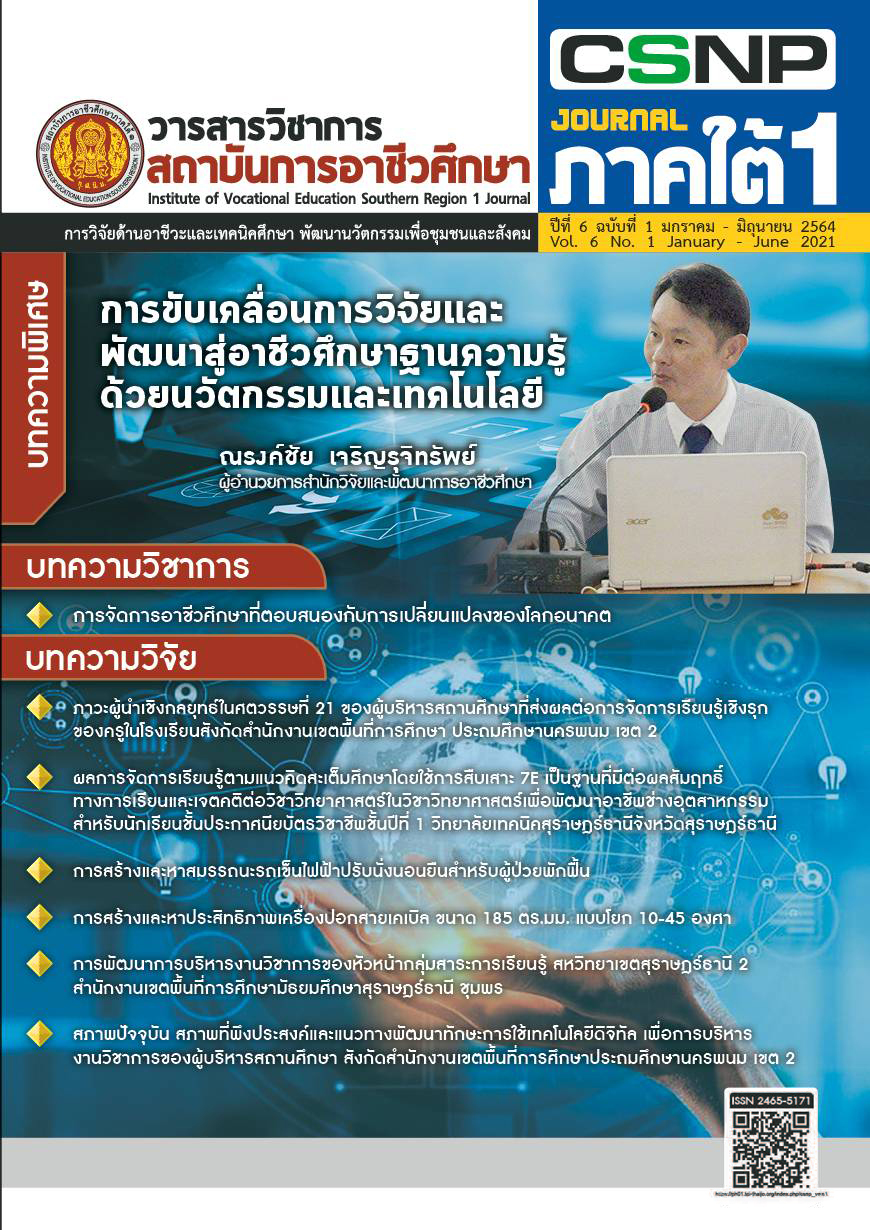The Development and Performance Finding of Electric Wheelchair with Adjustable Seat Position for Recuperating Patient
Keywords:
Electric Wheelchair, Recuperating PatientAbstract
This research aims to develop, find the performance of an electric wheelchair that can adjust the position for reclining, sitting, and seat lifting standing for recuperating patients, and study the user’s satisfaction. The sample included 30 recuperating patients who had to spend their life on a wheelchair for their daily activities in Phanom Subdistrict, Phanom District, Surat Thani Province. They were selected through purposive sampling technique.
The research instrument was a record form and satisfaction questionnaires analyzed by percentage, mean, standard deviation.The results showed that the developed electric wheelchair with adjustable seat position for recuperating patient consists of 3 sets of linear motor, a set of circuit control box for adjusting the position, driving motor wheels with a battery as an electric source, stainless steel wheelchair structure, and waterproof leather cushion. The experiments on motion performance included various ground conditions with the results as follows: 100% performance on flat surface, 90%performance on grass, and 90 % on rough terrain. The time for adjusting the position from sitting to lying was at the average of 1.18 to 1.22 minutes, from lying to sitting was at the average of 1.20 to 1.25 minutes, and from sitting to standing was at the average of 1.20 to 1.25 minutes. When climbing the ramp, users can assess the ratio of 1:6. The alarm function, emergency sound, and battery status of the developed electric wheelchair could regularly perform well. When evaluating the satisfaction of users, it is found that the overall satisfaction level is very high followed the hypothesis.
References
กรมส่งเสริมและพัฒนาคุณชีวิตคนพิการ. (2562). [ออนไลน์]. รายงานข้อมูลสถานการณ์ด้านคนพิการในประเทศไทย. [สืบค้นเมื่อวันที่ 25 ตุลาคม 2662]. จาก http://dep.go.th/Content/View/4232/1.
สถาบันสิรินธรเพื่อการฟื้นฟูสมรรถภาพทางการแพทย์แห่งชาติ. (2558). คู่มือสำหรับประชาชนในการฟื้นฟูสมรรถภาพทางการแพทย์พื้นฐานสำหรับคนพิการทางการเคลื่อนไหว. กรมการแพทย์ กระทรวงสาธารณสุข. นนทบุรี : สหมิตรพริ้นติ้งแอนด์พับลิสชิ่ง.
สุจินต์ วังใหม่ พิเชษฐ์ โค้วตระกูล และปิยะ กรกชจินตนาการ. (2559). การสร้างรถนั่งคนพิการแบบปรับท่านั่ง-ยืนได้. วารสารวิชาการสถาบันการอาชีวศึกษาภาคใต้ 1. ปีที่ 1 ฉบับที่ 1 มกราคม-มิถุนายน 2559. 66-70.
บุญธรรม กิจปรีดาบริสุทธิ์. (2546). สถิติวิเคราะห์เพื่อการวิจัย. นครนายก : สำนักพิมพ์จุฬาลงกรณ์มหาวิทยาลัย.
บุญชม ศรีสะอาด. (2553). วิธีการทางสถิติเพื่อการวิจัย. กรุงเทพมหานคร : สุวีริยาสาส์น.
เดชฤทธิ์ มณีธรรม. (2552). รถเข็นผู้พิการที่ควบคุมด้วยไมโครคอนโทรเลอร์. มหาวิทยาลัยเทคโนโลยีราชมงคลธัญบุรี, ปทุมธานี
สมศักดิ์ เปรมประสงค์. (2553). รถนั่งเคลื่อนที่อเนกประสงค์. ปทุมธานี : สถาบันวิจัยวิทยาศาสตร์และเทคโนโลยีแห่งประเทศไทย.



